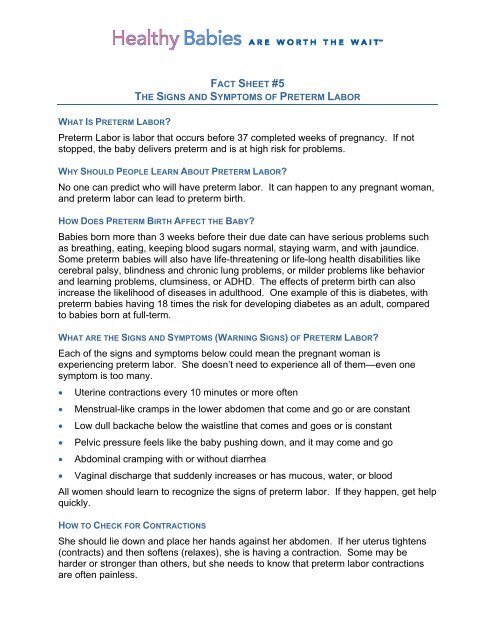The Signs and Symptoms of Preterm Labor
The Signs and Symptoms of Preterm Labor
The Signs and Symptoms of Preterm Labor
You also want an ePaper? Increase the reach of your titles
YUMPU automatically turns print PDFs into web optimized ePapers that Google loves.
FACT SHEET #5THE SIGNS AND SYMPTOMS OF PRETERM LABORWHAT IS PRETERM LABOR?<strong>Preterm</strong> <strong>Labor</strong> is labor that occurs before 37 completed weeks <strong>of</strong> pregnancy. If notstopped, the baby delivers preterm <strong>and</strong> is at high risk for problems.WHY SHOULD PEOPLE LEARN ABOUT PRETERM LABOR?No one can predict who will have preterm labor. It can happen to any pregnant woman,<strong>and</strong> preterm labor can lead to preterm birth.HOW DOES PRETERM BIRTH AFFECT THE BABY?Babies born more than 3 weeks before their due date can have serious problems suchas breathing, eating, keeping blood sugars normal, staying warm, <strong>and</strong> with jaundice.Some preterm babies will also have life-threatening or life-long health disabilities likecerebral palsy, blindness <strong>and</strong> chronic lung problems, or milder problems like behavior<strong>and</strong> learning problems, clumsiness, or ADHD. <strong>The</strong> effects <strong>of</strong> preterm birth can alsoincrease the likelihood <strong>of</strong> diseases in adulthood. One example <strong>of</strong> this is diabetes, withpreterm babies having 18 times the risk for developing diabetes as an adult, comparedto babies born at full-term.WHAT ARE THE SIGNS AND SYMPTOMS (WARNING SIGNS) OF PRETERM LABOR?Each <strong>of</strong> the signs <strong>and</strong> symptoms below could mean the pregnant woman isexperiencing preterm labor. She doesn’t need to experience all <strong>of</strong> them—even onesymptom is too many.• Uterine contractions every 10 minutes or more <strong>of</strong>ten• Menstrual-like cramps in the lower abdomen that come <strong>and</strong> go or are constant• Low dull backache below the waistline that comes <strong>and</strong> goes or is constant• Pelvic pressure feels like the baby pushing down, <strong>and</strong> it may come <strong>and</strong> go• Abdominal cramping with or without diarrhea• Vaginal discharge that suddenly increases or has mucous, water, or bloodAll women should learn to recognize the signs <strong>of</strong> preterm labor. If they happen, get helpquickly.HOW TO CHECK FOR CONTRACTIONSShe should lie down <strong>and</strong> place her h<strong>and</strong>s against her abdomen. If her uterus tightens(contracts) <strong>and</strong> then s<strong>of</strong>tens (relaxes), she is having a contraction. Some may beharder or stronger than others, but she needs to know that preterm labor contractionsare <strong>of</strong>ten painless.
WHAT IS THE DIFFERENCE BETWEEN PRETERM LABOR CONTRACTIONS AND BRAXTON HICKSCONTRACTIONS?While it can sometimes be normal for the uterus to contract <strong>of</strong>f <strong>and</strong> on during pregnancy(Braxton Hicks), these are more likely to occur when she first lies down, after sex, orafter she walks up <strong>and</strong> down stairs. However, it is not normal to have regular, frequentcontractions before the pregnancy reaches full-term. If she experiences 6 or morecontractions in 1 hour, then her uterus is contracting too <strong>of</strong>ten <strong>and</strong> this puts thepregnancy at risk for preterm labor. She should call her health care provider right awayif this happens.WHAT OTHER SYMPTOMS SHOULD BE REPORTED TO THE HEALTH CARE PROVIDER?She should call right away if:• She has any water coming from her vagina• She has any blood coming from her vagina• She experiences any <strong>of</strong> the signs <strong>and</strong> symptoms <strong>of</strong> preterm laborWaiting too long to call for help could result in the baby being born too early.Depending on her symptoms, the health care provider may tell her to come to thehospital immediately, or may recommend other ways to further evaluate the situation.WHAT CAN PREGNANT WOMEN DO?Learn the things to do that help a pregnancy go to full-term. She should tell her doctor ifshe has had a previous baby that was born before 37 weeks; that is the strongestpredictor that the next baby might be preterm, <strong>and</strong> the doctor will want to watch her <strong>and</strong>the baby more closely. Learn the warning signs <strong>of</strong> preterm labor <strong>and</strong> react quickly ifthey happen; get the help needed to try to prevent the baby from being born too early.If the doctor advises her to deliver before 39 weeks, she should underst<strong>and</strong> the medicalreasons why <strong>and</strong> be aware that there are risks involved with having a scheduledinduction <strong>of</strong> labor, <strong>and</strong>/or a scheduled Cesarean section without medical reasons. Sheshould discuss with her provider how to maximize the chances for a healthy, full-termbaby. (See also Fact Sheet #9.)Remember that Healthy Babies are Worth the Wait!2






